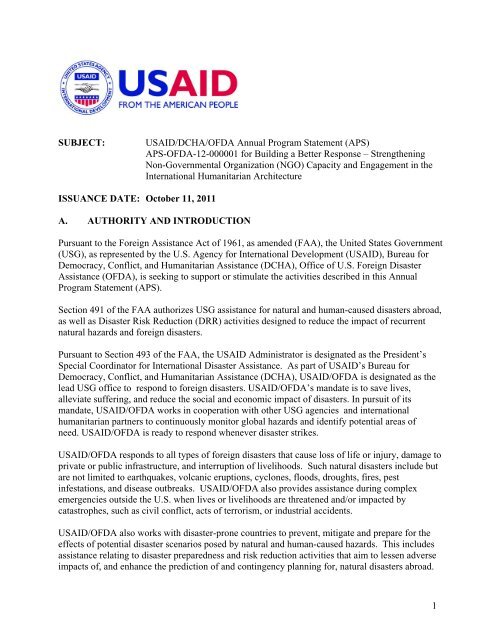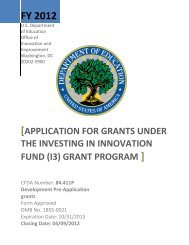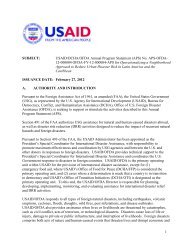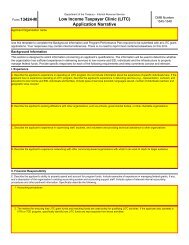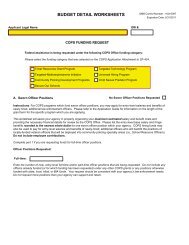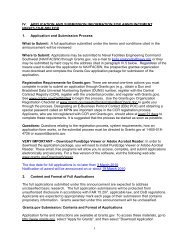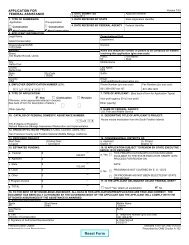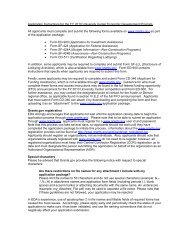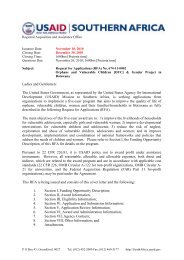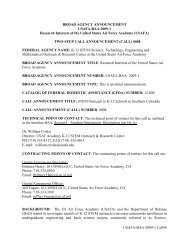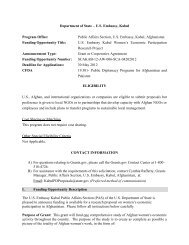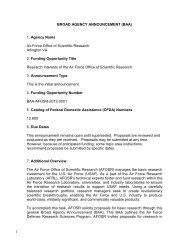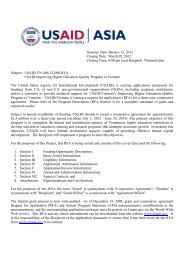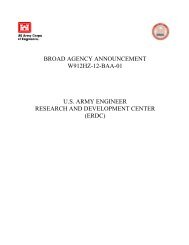USAID/DCHA/OFDA Annual Program Statement - Grants.gov
USAID/DCHA/OFDA Annual Program Statement - Grants.gov
USAID/DCHA/OFDA Annual Program Statement - Grants.gov
Create successful ePaper yourself
Turn your PDF publications into a flip-book with our unique Google optimized e-Paper software.
SUBJECT:<strong>USAID</strong>/<strong>DCHA</strong>/<strong>OFDA</strong> <strong>Annual</strong> <strong>Program</strong> <strong>Statement</strong> (APS)APS-<strong>OFDA</strong>-12-000001 for Building a Better Response – StrengtheningNon-Governmental Organization (NGO) Capacity and Engagement in theInternational Humanitarian ArchitectureISSUANCE DATE: October 11, 2011A. AUTHORITY AND INTRODUCTIONPursuant to the Foreign Assistance Act of 1961, as amended (FAA), the United States Government(USG), as represented by the U.S. Agency for International Development (<strong>USAID</strong>), Bureau forDemocracy, Conflict, and Humanitarian Assistance (<strong>DCHA</strong>), Office of U.S. Foreign DisasterAssistance (<strong>OFDA</strong>), is seeking to support or stimulate the activities described in this <strong>Annual</strong><strong>Program</strong> <strong>Statement</strong> (APS).Section 491 of the FAA authorizes USG assistance for natural and human-caused disasters abroad,as well as Disaster Risk Reduction (DRR) activities designed to reduce the impact of recurrentnatural hazards and foreign disasters.Pursuant to Section 493 of the FAA, the <strong>USAID</strong> Administrator is designated as the President’sSpecial Coordinator for International Disaster Assistance. As part of <strong>USAID</strong>’s Bureau forDemocracy, Conflict, and Humanitarian Assistance (<strong>DCHA</strong>), <strong>USAID</strong>/<strong>OFDA</strong> is designated as thelead USG office to respond to foreign disasters. <strong>USAID</strong>/<strong>OFDA</strong>’s mandate is to save lives,alleviate suffering, and reduce the social and economic impact of disasters. In pursuit of itsmandate, <strong>USAID</strong>/<strong>OFDA</strong> works in cooperation with other USG agencies and internationalhumanitarian partners to continuously monitor global hazards and identify potential areas ofneed. <strong>USAID</strong>/<strong>OFDA</strong> is ready to respond whenever disaster strikes.<strong>USAID</strong>/<strong>OFDA</strong> responds to all types of foreign disasters that cause loss of life or injury, damage toprivate or public infrastructure, and interruption of livelihoods. Such natural disasters include butare not limited to earthquakes, volcanic eruptions, cyclones, floods, droughts, fires, pestinfestations, and disease outbreaks. <strong>USAID</strong>/<strong>OFDA</strong> also provides assistance during complexemergencies outside the U.S. when lives or livelihoods are threatened and/or impacted bycatastrophes, such as civil conflict, acts of terrorism, or industrial accidents.<strong>USAID</strong>/<strong>OFDA</strong> also works with disaster-prone countries to prevent, mitigate and prepare for theeffects of potential disaster scenarios posed by natural and human-caused hazards. This includesassistance relating to disaster preparedness and risk reduction activities that aim to lessen adverseimpacts of, and enhance the prediction of and contingency planning for, natural disasters abroad.1
Disaster planning and preparedness identifies the hazards present in a country or region; thevulnerability of people and infrastructure; and the resources available for relief, rehabilitation,and reconstruction efforts. Recognizing the benefits in lives and resources saved, <strong>USAID</strong>/<strong>OFDA</strong>provides DRR assistance to reduce risks to vulnerable people and property.Since the inception of humanitarian reform in late 2004, <strong>USAID</strong>/<strong>OFDA</strong> has led USG engagement effortsin the four pillars of reform – providing policy, strategic, technical and financial support. The USGremains committed to supporting humanitarian reform efforts and strengthening the overall humanitarianarchitecture. Together with other donors, <strong>USAID</strong>/<strong>OFDA</strong> and other parts of the USG work to strengthenUN and NGO participation.The purpose of this APS is to disseminate information to enable prospective applicants to decidewhether to seek <strong>USAID</strong>/<strong>OFDA</strong> funding in support of an initiative called “Building a BetterResponse – Strengthening NGO Capacity and Engagement in the InternationalHumanitarian Architecture” and, if so, to assist them in developing and submitting applications.<strong>USAID</strong>/<strong>OFDA</strong> assumes no liability for reimbursing potential applicants for any costs they incur inthe preparation and submission of applications.This APS: (1) provides contextually relevant background information; (2) describes the programaim, results, and types of activities for which applications will be considered; (3) describes thelevel of funding available and the process and requirements for submitting applications; (4)explains the criteria for evaluating and selecting applications; and (5) refers prospectiveapplicants to related documentation available on the Internet.<strong>USAID</strong>/<strong>OFDA</strong>’s Guidelines for Unsolicited Proposals and Reporting (available athttp://www.usaid.<strong>gov</strong>/our_work/humanitarian_assistance/disaster_assistance/resources/#grants)do not apply to APS submissions. However, many parts of those Guidelines are equallyapplicable regardless of whether <strong>USAID</strong>/<strong>OFDA</strong> solicits applications (such as through this APS)or if an organization submits an unsolicited application. Therefore in order to preventunnecessary redundancies, parts of this APS may refer potential applicants to those Guidelinesand/or may specify that it is an explicit exception to those Guidelines. In the event of anyinconsistencies between this APS and those Guidelines, this APS shall prevail.The preferred method of distribution of <strong>USAID</strong> APS’ is electronically via http://www.grants.<strong>gov</strong>(“<strong>Grants</strong>.<strong>gov</strong>”), which provides a single source for USG-wide competitive grant opportunities.While applicants may submit applications via <strong>Grants</strong>.Gov the preferred method of submission is via<strong>OFDA</strong>_APS@ofda.<strong>gov</strong> . This APS and any future amendments or additions can be downloadedfrom <strong>Grants</strong>.Gov. In order to use this method, an applicant must first register on-line with<strong>Grants</strong>.Gov. If the applicant has difficulty registering or accessing the APS or related documents,the applicant should contact the <strong>Grants</strong>.<strong>gov</strong> Helpdesk at 1-800-518-4726 or via e-mail atsupport@grants.<strong>gov</strong> for technical assistance. It is the responsibility of the recipient of the APS andany related documentation to ensure that it has been received from <strong>Grants</strong>.Gov in its entirety and<strong>USAID</strong> bears no responsibility for data errors resulting from transmission or conversion processes.It is important that interested organizations sign-up for e-mail updates with <strong>Grants</strong>.Gov so that aschanges are posted to this and other USG (including <strong>USAID</strong>) solicitations, alerts will be received.2
B. SPECIFIC PROGRAMMATIC GUIDANCE1. BackgroundFollowing a review of the global humanitarian system that produced the Humanitarian ResponseReview in August 2005, the United Nations (UN) generated a number of UN and non-UNactions aimed at improving performance in humanitarian emergencies. In late 2005, the UNInter-Agency Standing Committee (IASC) launched a humanitarian reform initiative thatemphasized capacity, accountability, predictability, leadership and partnership by establishingnew structures to strengthen coordination through a new “cluster approach”; reforming theexisting “Humanitarian Coordinator (HC)” system to provide improved leadership; developingnew “financing mechanisms” to facilitate better financing; and advancing “partnerships”between UN and non-UN entities.Since then, the cluster approach has become accepted as an essential element of humanitarianresponse. Furthermore, the Central Emergency Response Fund (CERF) and other pooled fundingmechanisms have played an important role in securing new and non-traditional donors anddollars to humanitarian emergencies, recruitment and training for HCs has been revamped, andhumanitarian partnerships have been strengthened and expanded in a variety of ways.The reforms introduced in 2005 have produced improvements in disaster response and ongoingevaluation of the reforms has resulted in course corrections to achieve the goals. A wide varietyof non-UN initiatives have contributed positively to humanitarian reform resulting in anenhanced dialogue within the international humanitarian community and better humanitarianassistance operations.In 2006, leaders in the NGO community, Red Cross/Red Crescent Societies, and UNhumanitarian organizations established the Global Humanitarian Platform (GHP). The GHPidentified partnership and a collaborative effort as the “fourth pillar” in humanitarian reform.Through the GHP, the “Principles of Partnership” were developed to highlight the need forequality, transparency, a results-oriented approach, and responsibility and complementarilyamong humanitarian actors to enhance the effectiveness of humanitarian action.Representing a broad membership that includes donors, academics, and individual experts inaddition to the UN, NGOs, and Red Cross/Red Crescent societies, the Active Learning Networkfor Accountability and Performance in Humanitarian Action (ALNAP) has worked for more thana decade to assess humanitarian response and provide tools for improving performance. <strong>USAID</strong>supported ALNAP’s State of the Humanitarian System, a pilot study released in early 2010,which included a working methodology to be used for future assessments of humanitarianresponse. Another significant NGO initiative which seeks to assure improved delivery,performance and accountability include the SPHERE Project that sets forth minimum standardsin each sector..Evaluations of the 2010 disasters in Haiti and Pakistan revealed to the international humanitariancommunity an urgent need to shift the overarching goal from humanitarian reform to a broaderfocus on improving the performance of the humanitarian assistance architecture. Spearheading a3
process to strengthen the response system, the IASC identified five key areas with an emphasison action: leadership, coordination, accountability, building global capacity for preparedness,and advocacy and communications. NGOs are contributing to the process at the IASC, and inparticular are involved in collaborating to help determine minimum commitments andresponsibilities of organizations involved in a cluster, as well as defining NGO participation inhumanitarian country teams (HCTs). In addition, donors are increasingly aggressive in efforts tocoordinate both at the field and headquarters levels on funding and advocacy within thetraditional international humanitarian community and within various new communities such asthe private sector, media, development efforts, and affected populations.Because every disaster brings a unique combination of international, regional, and local players,and each country’s resources to address a disaster are distinct, instruction and training about howto improve the performance of the humanitarian assistance architecture continue to be one of themost prevalent needs identified in studies about international humanitarian response to disasters.High staff turnover is a frequent problem among INGOs and other international organizationsparticularly when conditions require a disaster response lasting more than several weeks; thus,the more NGO staff who understand the goals of international humanitarian assistancearchitecture and technical application of best practices, the more conducive the environment willbe to achieving an effective response. Furthermore, national staff of INGOs may have limitedexposure to the larger workings of the humanitarian assistance architecture, and have difficultyengaging with international staff from UN agencies and other multilateral organizations.International staff who respond to humanitarian emergencies frequently deploy from outside theaffected country with little prior knowledge of conditions on the ground. A broaderunderstanding among humanitarian actors of the international humanitarian architecture androles and responsibilities can help strengthen relationships in-country where such relationshipsoften form the basis for collaboration and inclusiveness during a disaster.The number of disasters rose during the past decade and will likely continue to rise. The UN,NGOs, and new actors in humanitarian disaster response have demonstrated that pre-disasterinstruction and training for those charged with the planning and delivery of humanitarianassistance has worked to improve the performance of the humanitarian assistance architecture. Aglobal view and comprehensive efforts are needed not only to evaluate performance but toactively engage more humanitarian actors in strengthening partnerships, operationalizingaccountability, and better advocating on critical issues such as humanitarian principles,preparedness, and early recovery.In 2010, a second evaluation of the Cluster System was carried out. In its findings, a number ofrecommendations were made pertaining to NGO’s involvement in humanitarian coordinationmechanisms. In particular, a) reinforcement of the role of international NGOs in clusters, b)facilitating the participation of national and local NGOs and strengthening their capacities c)further strengthen learning, and finally d) strengthening training on facilitation, coordination andcross-cutting issues on the national and subnational levelsThe USG is a leader among donors in engaging in improving the performance of thehumanitarian assistance architecture through financial, technical, and policy support. Through4
Creative thinking on the part of the APS applicant on how best to engage national andinternational NGOs on their roles in the cluster approach, humanitarian financing, andpartnerships (UN, NGO, regional entities, affected populations, and non-traditional actorsamong others) and participation within the existing frameworks and system (rather thancreating new parallel systems).Workshops that provide intensive courses for small groups, accentuating problemsolving.Exercises to diagnose problems and offer instruction in a particular activity. This caninclude simulations with supervised practical application of potential humanitarianemergency scenarios.The USG fully supports efforts to improve the performance of the humanitarian assistancearchitecture. Training curriculum must support the established architecture as well as provideinnovative techniques and approaches for strengthening its application in close coordination withkey UN agencies, including the Office for the Coordination of Humanitarian Affairs (OCHA).Applicants are encouraged to make use of existing training materials where relevant which couldbe adapted to suit specific audiences.<strong>USAID</strong>/<strong>OFDA</strong> seeks training and instruction programs that target the range of individuals mostlikely to be directly involved in future humanitarian disasters including headquarters staff,country directors, and field level practitioners. <strong>USAID</strong>/<strong>OFDA</strong> encourages engagement with theUN in APS applicants’ programs and reaching out to the NGO humanitarian community.3. <strong>Program</strong> DurationThe program duration is for up to 24 months from the date of award. <strong>USAID</strong>/<strong>OFDA</strong> plans to fundapproved activities starting in fiscal year 2012, but reserves the right to incrementally fundactivities over the duration of the program, if necessary, depending on program length, performanceagainst approved program indicators and availability of funds.4. Anticipated Funding Availability<strong>USAID</strong>/<strong>OFDA</strong> anticipates that up to approximately US$3 million will be available to support theprogram(s) or activity(ies) described herein, although final funding levels will depend on thecontent, quality, number of applications received, needs, availability of funding, and competingpriorities.While no ceiling has been established on the magnitude of individual applications, applicants areencouraged to keep costs reasonable in relation to the scope of their proposed activities,recognizing that the total funding under this APS will cover a range of efforts.6
5. Anticipated Number of Awards<strong>USAID</strong>/<strong>OFDA</strong> plans to make one or two awards under this APS. Nevertheless, <strong>USAID</strong>/<strong>OFDA</strong>reserves the right to make a single award, to fund parts of applications, or not to make anyawards at all. Issuance of this APS does not constitute an award commitment on the part of theU.S. Government, nor does it commit the U.S. Government to pay for any costs incurred in thepreparation and submission of any application. <strong>USAID</strong>/<strong>OFDA</strong> also reserves the right to make noaward should there be a lack of strong applications.6. Type of Award(s)/Substantial Involvement<strong>USAID</strong>/<strong>OFDA</strong> anticipates that a cooperative agreement(s) will be awarded as a result of thisAPS. Cooperative agreements are identical to grants except that <strong>USAID</strong>/<strong>OFDA</strong> will besubstantially involved in the following areas:(a) <strong>USAID</strong>/<strong>OFDA</strong> approval of the recipient’s detailed implementation plans thatinclude start up and implementation activities (limited to not more frequently than annually);(b) <strong>USAID</strong>/<strong>OFDA</strong> approval of specified key personnel (limited to 5 positions or5% of the recipient’s total team size, whichever is greater);(c) <strong>USAID</strong>/<strong>OFDA</strong> and recipient collaboration or joint participation whichincludes one or more of the following: Collaborative involvement of selection of advisory committeemembers (<strong>USAID</strong>/<strong>OFDA</strong> may also choose to become a member), if applicable; <strong>USAID</strong>/<strong>OFDA</strong> concurrence in advance on the selection of sub-awardrecipients and/or the substantive technical/programmatic) provisions of sub-awards; <strong>USAID</strong>/<strong>OFDA</strong> approval of a program monitoring and evaluation[M&E] plan (to the extent that such information is not included in the application); and <strong>USAID</strong>/<strong>OFDA</strong> monitoring to permit direction or redirection becauseof interrelationships with other projects.7. Cost-Sharing (Matching)NGOs are not required to include counterpart funding. However, applications that includeadditional in-kind and/or cash contributions from non-USG sources will be more competitive, sincecost-sharing demonstrates a strong commitment to the planned activities and will be rewardedunder the “cost-effectiveness” evaluation criterion set forth in F below. Cost-sharing will besubject to 22 CFR 226.23 and the standard provision entitled “Cost Sharing (Matching)” (U.S.NGOs) or the standard provision entitled “Cost-Sharing (Matching)” for non-U.S. NGOs (see G 2below).7
8. <strong>Program</strong> IncomeIf the successful applicant(s) is/are a non-profit organization, any program income generated underthe award(s) will be added to <strong>USAID</strong>/<strong>OFDA</strong> funding (and any cost-sharing that may be provided)and used for program purposes. However, pursuant to 22 CFR 226.82, if the successful applicant isa for-profit organization, any program income generated under the award(s) will be deducted fromthe total program cost to determine the amount of <strong>USAID</strong>/<strong>OFDA</strong> funding. <strong>Program</strong> income will besubject to 22 CFR 226.24 (U.S. NGOs) or the standard provision entitled “<strong>Program</strong> Income” fornon-U.S. NGOs (see G 2 below).9. Authorized Geographic Code<strong>USAID</strong>’s rules for the source, origin, and componentry of goods (other than “restricted goods,” asdescribed in ADS 312 [http://www.usaid.<strong>gov</strong>/policy/ads/300/312.pdf]), and the nationality ofsuppliers of goods and services (other than delivery services, as described in ADS 314[http://www.usaid.<strong>gov</strong>/policy/ads/300/314.pdf]) , which are financed by <strong>USAID</strong> and procured bythe recipient under the award(s) resulting from this APS, are set forth in 22 CFR 228(http://www.access.gpo.<strong>gov</strong>/nara/cfr/waisidx_08/22cfr228_08.html). These rules do not apply toprocurement by the recipient with cost-sharing or program income funds. Except as authorizedunder <strong>USAID</strong>’s “Local Procurement” rules (see 22 CFR 228.40), the authorized geographic code(see 22 CFR 228.1) for the award(s) resulting from this APS is 935, subject to the recipient’scompliance with the order of preference and file documentation requirements set forth in paragraph(b)(1) of the standard provision entitled “<strong>USAID</strong> Eligibility Rules for Goods and Services” (see Gbelow).10. Title to PropertyTitle to property financed by <strong>USAID</strong>/<strong>OFDA</strong> under the award(s) will vest in the recipient, and willbe subject to 22 CFR 226.30-37 (U.S. NGOs) or the standard provision entitled “Title To and Useof Property (Recipient Title; Over $50,000) for non-U.S. NGOs (see G 2 below).11. Post-Award Reporting(a)<strong>Program</strong>matic Reporting<strong>Program</strong>matic reporting will be in accordance with the <strong>USAID</strong>/<strong>OFDA</strong> Guidelines for UnsolicitedProposals and Reporting (see E 1 below). Quarterly program performance reports are required.(b)Financial Reporting and PaymentFinancial reporting will depend on the payment provisions of the award, which cannot bedetermined until after the successful applicant(s) is/are selected. Advance payments will generallybe made if the applicant’s systems, policies, and procedures meet USG and <strong>USAID</strong> requirements(see C 1 [c]). The recipient(s) may be required to have a U.S. bank account into which paymentsunder the award will be made.8
C. APPLICANT ELIGIBILITY<strong>USAID</strong>/<strong>OFDA</strong> will not accept applications from individuals. All applicants must be legallyrecognized organizational entities under applicable law. ALL applicants must be currentlyregistered in the Central Contractor Registration (CCR) database and must include the dateof their CCR expiration. For registration go to https://www.bpn.<strong>gov</strong>/ccr/default.aspxThe following types of organizations may apply for <strong>USAID</strong>/<strong>OFDA</strong> funding under this APS:1. Non-Governmental Organizations (NGOs)NGOs are encouraged to partner with each other to apply.(a)Types and Nationalities of NGOs(1) U.S. and Non-U.S. Non-Profit OrganizationsQualified U.S. and non-U.S. private non-profit organizations may apply for <strong>USAID</strong>/<strong>OFDA</strong> fundingunder this APS. Foreign <strong>gov</strong>ernment-owned parastatal organizations from countries that areineligible for assistance under the FAA or related appropriations acts are ineligible.(2) U.S. and Non-U.S. Colleges and UniversitiesQualified U.S. and non-U.S. colleges and universities may apply for <strong>USAID</strong>/<strong>OFDA</strong> funding underthis APS. USG and <strong>USAID</strong> regulations generally treat colleges and universities as NGOs, ratherthan <strong>gov</strong>ernmental organizations; hence, both public and private colleges and universities areeligible. Non-U.S. colleges and universities in countries that are ineligible for assistance under theFAA or related appropriations acts are ineligible.(b)Registration as a Private Voluntary Organization (PVO)Pursuant to ADS E251.5.3.(a)6, applicants do not need to be registered with <strong>USAID</strong> as a PVO to beeligible for funding under this APS.(c)“Responsibility” of ApplicantIn order for an award to be made, the Agreement Officer must make an affirmative determinationthat the applicant is “responsible,” as discussed in ADS 303.3.9. This means that the applicantmust possesses, or have the ability to obtain, the necessary management and technicalcompetence to conduct the proposed program, and must agree to practice mutually agreed-uponmethods of accountability for funds and other assets provided or funded by <strong>USAID</strong>.The following criteria are used by <strong>USAID</strong> in determining an applicant’s “responsibility:”Monitoring System.(1) Adequacy of Applicant’s <strong>Program</strong> Description, Budget, and9
Performance.(2) Adequacy of the Applicant’s Financial Resources for <strong>Program</strong>(3) Applicant’s Ability to Meet Award Conditions:(A) Compliance of Applicant’s Accounting and OverallFinancial and <strong>Program</strong> Management Systems with 22 CFR 226.20-28.with 22 CFR 226.50-53.(B)Compliance of Applicant’s System of Reports and Records(C)Applicable USG Cost Principles.Compliance of Applicant’s Internal Control Systems withUSG Cost Principles.(i)(ii)Internal Controls.Personnel Policy is Reasonable under Applicable(iii) Travel Policy is Reasonable under Applicable USGCost Principles and the U.S. Department of State’s Standardized Regulations (GovernmentCivilians, Foreign Areas) (http://aoprals.state.<strong>gov</strong>/), and Complies with Fly AmericaRequirements.with 22 CFR 226.30-37.(D)Compliance of Applicant’s Property Management System(E) Compliance of Applicant’s Sub-Award Administration andMonitoring System with OMB Circular A-133 (U.S. NGOs) or the <strong>USAID</strong> Inspector-General’sGuidelines for Financial Audits Contracted by Foreign Recipients(http://www.usaid.<strong>gov</strong>/policy/ads/500/591maa.pdf) for non-U.S. NGOs.(F)Procedures with 22 CFR 226.40-49.(G)Potential Work Commitments.Compliance of Applicant’s Purchasing System/ContractingApplicant’s Absorptive Capacity Given Other Existing and(4) Satisfactory Record of Performance by Applicant.(5) Satisfactory Record of Business Integrity by Applicant.` (6) Applicant is Otherwise Qualified to Receive an Award underApplicable Laws and Regulations (e.g., Nondiscrimination, Lobbying, Debarment/Suspension,Terrorist Financing, etc.).10
In the absence of an affirmative “responsibility” determination, an award can ordinarily not bemade. However, in rare cases, an award can be made with “special award conditions” (i.e.,additional non-standard award requirements designed to minimize the risk presented to <strong>USAID</strong>of making an award to an NGO for which an affirmative determination of “responsibility” cannotbe made), but only where it appears likely that the applicant can correct the deficiencies in areasonable period.(d)New PartnersPartners new to <strong>USAID</strong> may submit applications. However, resultant awards to these organizationsmay be significantly delayed if <strong>USAID</strong>/<strong>OFDA</strong> must undertake necessary pre-award reviews ofthese organizations to determine their “responsibility” (see subparagraph [c] above). Theseorganizations should take this into account and plan their implementation dates and activitiesaccordingly.2. Other USG AgenciesUSG departments and agencies may not apply for <strong>USAID</strong>/<strong>OFDA</strong> funding under this APS.3. U.N. AgenciesU.N. agencies may not apply for <strong>USAID</strong>/<strong>OFDA</strong> funding under this APS.4. Code of ConductAs a condition for any award resulting from this APS, applicants must have adopted a code ofconduct that addresses the protection of beneficiaries of assistance from sexual exploitation andabuse in humanitarian relief operations. Such code of conduct is described in the “Notices”section (page 1) of the <strong>OFDA</strong> Guidelines for Unsolicited Proposals and Reporting.D. SELECTION PROCESS AND SCHEDULE1. Selection ProcessApplications will be evaluated in accordance with the criteria set forth in Section F below. Afterevaluation of the applications, either award(s) will be made, or, if deemed necessary or desirable by<strong>USAID</strong>/<strong>OFDA</strong>, written and/or verbal discussions/negotiations will be conducted with applicantsthat submit the most highly rated applications. After the conclusion of any suchdiscussions/negotiations, such applicants will, unless otherwise advised, be required to submit arevised application, which will be re-evaluated against the criteria set forth in Section F below.Ordinarily, award(s) will be made after the first round of any such discussions/negotiations andrevised applications; however, <strong>USAID</strong>/<strong>OFDA</strong> reserves the right to conduct subsequent rounds ofdiscussions/negotiations and revised applications, and to limit the number of applicants with whomsuch subsequent discussions/negotiations would be conducted and revised applications requested.11
2. ScheduleThis APS is open for six months from the date of issuance, although <strong>USAID</strong>/<strong>OFDA</strong> plans to reviewapplications in batches. Applications received no later than 4:00 p.m. Eastern Time (ET) onDecember 12, 2011 will be included in the first batch of applications for review.Questions concerning the first batch of applications under this APS must be received no later thanOctober 18, 2011. Following this date, the questions received by that date, if any, (withoutattribution to the organization), and answers will be posted as an amendment to this APS ifnecessary in submitting applications or if the lack of such information would be prejudicial to anyother prospective applicant. Questions must be in writing and should be e-mailed to<strong>OFDA</strong>_APS@<strong>OFDA</strong>.GOVOral explanations or instructions given before award(s) is/are made will not be binding.This APS may be amended either to establish subsequent deadlines or to indicate that an award(s)has/have been made and that no further funding is available. If an award(s) results from the firstbatch of reviewed applications, the award date is anticipated to be o/a January 9, 2012. Lateapplications will only be considered under subsequent batches of applications, if any.E. GENERAL GUIDANCE1. <strong>USAID</strong>/<strong>OFDA</strong> Guidelines for Unsolicited Proposals and ReportingExcept as may be stated otherwise in this APS, applicants must submit their applications incompliance with the <strong>USAID</strong>/<strong>OFDA</strong> Guidelines for Unsolicited Proposals and Reporting.Applications that do not adhere to those Guidelines will not be considered for funding.<strong>USAID</strong>/<strong>OFDA</strong>’s Guidelines for Unsolicited Proposals and Reporting, which is available athttp://www.usaid.<strong>gov</strong>/our_work/humanitarian_assistance/disaster_assistance/resources/#grants.In the event of inconsistencies between this APS and those Guidelines, this APS shall prevail.Applicants are also encouraged to review Results-Oriented Assistance: A <strong>USAID</strong> Sourcebook(http://www.usaid.<strong>gov</strong>/pubs/sourcebook/us<strong>gov</strong>/), which may also prove helpful in preparingapplications.2. Content of ApplicationsUnder this APS, all proposed activities must fall under the Humanitarian Coordination andInformation Management sector(s) and the Coordination and Information Managementsubsector(s), as described in those Guidelines. As noted in those Guidelines, at least one of theindicators for each subsector must be used. Applicants are requested to state in their applications:(1) the estimated cost per person receiving training under this program; and (2) the percentage ofthe total affected population (by administrative unit or site) to be served under any resulting award.Applicants must consider the role that gender plays, demonstrate an understanding and sensitivityto the real or perceived impact that gender and other personal attributes may have on personalsecurity, and include a plan for achieving gender-integration and -balance.12
It is recognized that, in some programs, identification of specific teaming partners and subrecipientscannot occur until after award and, hence, specific delineation of responsibilities andcosts cannot be provided in the application. Nevertheless, such information is, in fact, often knownat the time the application is being prepared. In order to reduce the post-award administrativeburden of obtaining post-award approval for such sub-awards, and thereby, facilitate programimplementation and the achievement of results in the timeframe of the award(s), applicants arestrongly encouraged to identify such teaming arrangements and sub-recipients in thetechnical/programmatic and cost/budget/management sections of their application, if any, to themaximum practicable extent. When such organizations are identified, Letters of Intent, Letters ofAgreement, or Memoranda of Understanding should be included in the application.It is the responsibility of applicants to ensure that local partners do not appear on the ExcludedParties List (which includes the U.S. Department of Treasury's Office of Foreign Assets Control“Specially Designated Nationals and Blocked Persons List”), which can be found at:http://www.epls.<strong>gov</strong>. Applicants working through local partners must ensure that localorganizations have the capacity to carry-out expanded programs, and should consider a capacitybuildingcomponent which will leave a lasting impact on local organizations.Applications must be submitted in English. Documentation in other languages may be included aslong as there is an English translation. Applications should use Word 2000 or newer and/or Excel2000 or newer. The signed certifications and representations (see Section V.H of the<strong>USAID</strong>/<strong>OFDA</strong> Guidelines for Unsolicited Proposals and Reporting) are required at the time ofsubmission of an application and may be provided in PDF format. Applications submitted withoutthe required signed documentation will not be considered.3. Place and Means of SubmissionApplications may be submitted via <strong>Grants</strong>.<strong>gov</strong> (see A above) however the preferred method ofsubmission is electronically to: <strong>OFDA</strong>_APS@<strong>OFDA</strong>.GOV. Copies in .zip format may not besubmitted since they are automatically quarantined by <strong>USAID</strong>’s computer security system.4. Communications with <strong>USAID</strong>/<strong>OFDA</strong>As an exception to the <strong>USAID</strong>/<strong>OFDA</strong> Guidelines for Unsolicited Proposals and Reporting,potential applicants may not have contact with <strong>USAID</strong>/<strong>OFDA</strong> except as described above.5. <strong>USAID</strong> Disability Policy and Accessibility StandardsThe applicant’s attention is directed to Section VI.A of the <strong>USAID</strong>/<strong>OFDA</strong> Guidelines forUnsolicited Proposals and Reporting. These policies have implications for both the programdesign and program budget.6. Voluntary Survey on Faith–Based and Community Organizations13
The applicant is encouraged, but is not required, to submit <strong>USAID</strong>’s Voluntary Survey on Faith-Based and Community Organizations, as described in Section VI.C of the <strong>USAID</strong>/<strong>OFDA</strong>Guidelines for Unsolicited Proposals and Reporting.7. Branding Strategy and Marking Plan (BS/MP)Applicants are required to comply with 22 CFR 226.91 (see G below) and <strong>USAID</strong> Acquisition andAssistance Policy Directive (AAPD) 05-11(http://www.usaid.<strong>gov</strong>/business/business_opportunities/cib/pdf/aapd05_11.pdf). As an exception toSection V.G of the <strong>USAID</strong>/<strong>OFDA</strong> Guidelines for Unsolicited Proposals and Reporting, applicantsare encouraged, but are not required, to submit their BS/MP with their applications. Applicantswho choose not to include their BS/MP with their application will not be penalized during theevaluation process, but should be aware that, if the applicant is the/an apparently successfulapplicant, the applicant will be required to submit an acceptable BS/MP as a prerequisite for anyresulting award. This would delay any such award, pending receipt and review of the applicant’sBS/MP. Moreover, because <strong>USAID</strong>’s branding and marking requirements have cost implications,such costs should be included in the application budget even if the applicant does not submit itsBS/MP with the application.8. Ineligible Goods and Services, Ineligible Suppliers, and Restricted GoodsThe applicant’s attention is directed to Section V.F of the <strong>USAID</strong>/<strong>OFDA</strong> Guidelines forUnsolicited Proposals, as well as ADS 313 (http://www.usaid.<strong>gov</strong>/policy/ads/300/313.pdf). Theserules and requirements may affect the program design, budget, timing of award, and/or timelyprogram implementation and post-award administrationF. EVALUATION CRITERIAApplications will be reviewed jointly by <strong>USAID</strong>/<strong>OFDA</strong>/Washington and <strong>OFDA</strong> field staff inaccordance with the following evaluation criteria. Other <strong>USAID</strong> staff, USG agencies,<strong>USAID</strong>/<strong>OFDA</strong> consultants, and other partners may also be invited to review applications on a caseby-casebasis provided that such participation does not create a conflict of interest, and furtherprovided that information contained in the application shall be used only for evaluation purposesand shall not be disclosed outside <strong>USAID</strong>/<strong>OFDA</strong>. Award(s) will be made to organization(s) whoseapplication(s) offer the best value to <strong>USAID</strong>.The evaluation criteria and their respective weight (out of a total of 100 points) are:1) Justification for Proposed Intervention(s) – 25 pointsThe applications will be evaluated based on the justification provided for the proposed program interms of:Identified need(s) based on assessments or surveys using sound methodology, and theappropriateness of proposed intervention(s) to meeting those needs.14
Needs have been quantified.The extent of the applicant’s attempt to obtain historical and/or baseline data so that thestatus of the situation can be assessed.The extent to which activities target identified needs and fill gaps in current humanitarianprograms.Consultation with targeted communities prior to submission of the application andincorporation of their concerns and needs into the application.2) <strong>Program</strong> Description - 25 pointsThe application shall be evaluated from a technical perspective in terms of:Level of innovation and creativity in the program design and implementation.The application provides sufficient detail for the concrete understanding of methods to beused and for a determination of technical appropriateness to be made.The activities are consistent with Section B of this APS.Appropriateness of proposed activities to addressing needs and <strong>USAID</strong>/<strong>OFDA</strong>’s objectiveswithin the proposed timeframe.Methodology for selecting the targeted population(s); target population clearly identifiedin terms of number, location, and current status.Description and understanding of the role that gender plays and plan for achieving genderintegration and balance; a demonstrated understanding and sensitivity to the real orperceived impact that gender and other personal attributes may have on personal security.Strength and realism of the Monitoring and Evaluation plan in measuring results and impactof the program.Appropriateness of proposed indicators; the organization has made an attempt to identifyimpact, as well as output, indicators.A well-planned transition/exit strategy that transfers activities to host <strong>gov</strong>ernmentinstitutions, local partners, and/or beneficiaries.3) Institutional Capability and Past Performance - 10 pointsApplicants will also be evaluated based on their institutional capability and past performance,specifically:Contextual knowledge of the global humanitarian assistance architecture.The applicant’s capability and competence in the activities being proposed, as demonstratedby relevant experience and technical expertise in previous programs at both headquarter andfield levels.Operational experience with working in the international humanitarian architecture.The applicant’s ability to begin implementation expeditiously.Past performance record, including relationships with U.S. and host <strong>gov</strong>ernment authoritiesand target populations (see Section VI.D.3 of the <strong>USAID</strong>/<strong>OFDA</strong> Guidelines for UnsolicitedProposals and Reporting).15
4) Sustainability - 15 pointsApplications will be evaluated for sustainability in terms of the applicant’s plan for howresources might be obtained to continue the activity or program, if appropriate (e.g., costrecoverymechanisms, discussions with development partners, etc.5) Coordination - 15 pointsApplications will be reviewed in terms of the described level of coordination, specifically:An overview of how the proposed activities will complement other planned or ongoinginitiatives (both those of the applicant and those of other partners/donors) in the country ofoperation (e.g., how the proposed activities will interact and be sequenced with otherhumanitarian initiatives in the operational area or adjacent areas (including Global level),how differing approaches are addressed in the proposed activities in order to minimizepotential conflict amongst beneficiary populations.).Demonstrated adherence to processes, guidelines and policies established by appropriatehost <strong>gov</strong>ernment institutions and/or international agencies.Incorporation of local institutions, organizations or beneficiary groups into the programplanning and implementation.6) Cost -- 5 pointsWith regard to cost, the following sub-criteria will be used:Cost-effectiveness: percentage of the overall budget which goes to direct assistance forbeneficiaries, and the significance of the program impact in terms of the number ofbeneficiaries and/or cost per beneficiary to <strong>USAID</strong>/<strong>OFDA</strong>.Cost realism: costs are consistent with likelihood that the program can be accomplishedwithin the stated budget.7) Security - 5 pointsIn terms of security, applications will be evaluated based on:Assessment of the applicant’s consideration of the security situation in the proposed areaof implementation and if the planned program and budget are structured accordingly.Applicant’s discussion of how the proposed program will adhere to the organization’ssecurity policy.G. AWARD ADMINISTRATION AND RELEVANT WEBSITES FOR REFERENCE1. U.S. Non-Governmental Organizations16
Awards to U.S. NGOs resulting from this APS will be administered in accordance with thefollowing:Chapter 303 of <strong>USAID</strong>'s Automated Directives System (ADS-303), which is available athttp://www.usaid.<strong>gov</strong>/policy/ads/300/303.pdf.22 CFR 226 which is available athttp://www.access.gpo.<strong>gov</strong>/nara/cfr/waisidx_03/22cfr226_03.html.2 CFR 220 for universities (formerly OMB Circular A-21); or2 CFR 230 for non-profit organizations (formerly OMB Circular A-122); andOMB Circular A-133 for both universities and non-profit organizations, all of which areavailable at http://www.whitehouse.<strong>gov</strong>/omb/circulars/index.html. 48 CFR 31.2 for for-profit organizations, which is available at http://www.arnet.<strong>gov</strong>/far/ .<strong>USAID</strong> Standard Provisions for U.S. Non-Governmental Organizations, which areavailable at: http://www.usaid.<strong>gov</strong>/pubs/ads/300/303maa.pdf.2. Non-U.S. Non-Governmental OrganizationsAwards to non-U.S. NGOs resulting from this APS will be administered in accordance with thefollowing:Chapter 303 of <strong>USAID</strong>'s Automated Directives System (ADS-303), which is available athttp://www.usaid.<strong>gov</strong>/policy/ads/300/303.pdf.2 CFR 220 for universities (formerly OMB Circular A-21); or2 CFR 230 for non-profit organizations (formerly OMB Circular A-122), both of whichare available at http://www.whitehouse.<strong>gov</strong>/omb/circulars/index.html.48 CFR 31.2 for for-profit organizations, which is available athttps://www.acquisition.<strong>gov</strong>/far/html/Subpart%2031_2.html .<strong>USAID</strong> Standard Provisions for Non-U.S. Non<strong>gov</strong>ernmental Organizations, which areavailable at: http://www.usaid.<strong>gov</strong>/policy/ads/300/303mab.pdf.22 CFR 226 which is available athttp://www.access.gpo.<strong>gov</strong>/nara/cfr/waisidx_03/22cfr226_03.html. Note that, while 22CFR 226 does not directly apply to non-U.S. NGOs, <strong>USAID</strong> policy is to apply thisregulation to non-U.S. NGOs to the extent practicable.17


